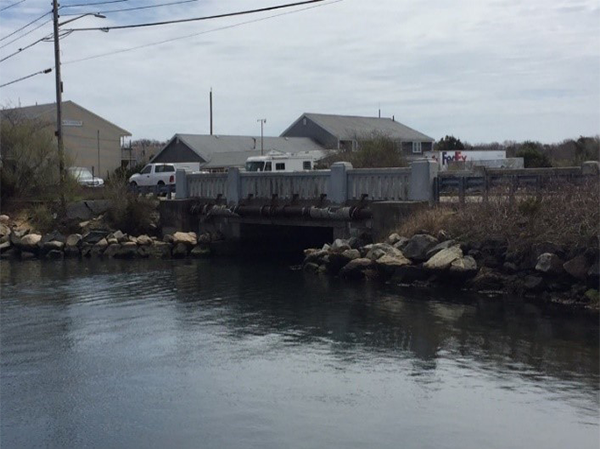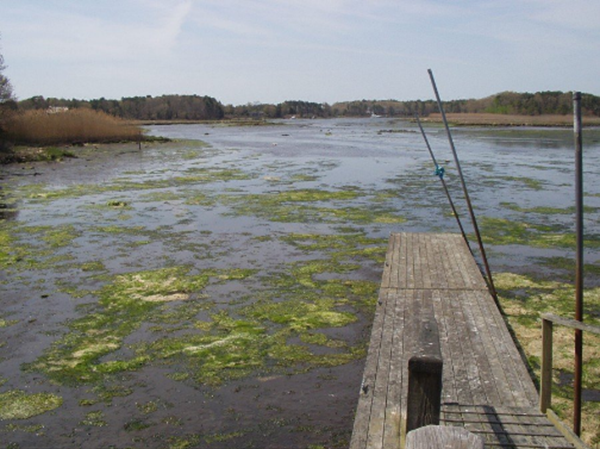Ecosystem Restoration Program Projects
- Home
- /
- Our Work
- /
- Science
- /
- Ecosystem Restoration Program
- /
- Ecosystem Restoration Program Projects
What types of projects does the ERP work on?
Salt marsh and fish run restoration projects that entail removal of tidal restrictions (human-created barriers such as undersized pipes or culverts (shown below), narrow bridge underpasses, or dams that limit or prevent natural tidal flow) and barriers to fish passage, to reestablish natural water flow, improve water quality, and restore habitat for native species.
Stormwater management projects to protect and improve water quality and habitat through collection and treatment of polluted stormwater runoff.
River and bog restoration projects that restore stream continuity and the natural floodplain of our streams and rivers while returning abandoned cranberry bogs to natural wetlands to provide habitat for fish and other wildlife.
Coastal resilience projects, such as dune restoration, to protect the Cape’s environment and inhabitants from impacts of coastal storms and sea level rise. Coastal Resilience is the ability of a community to ‘bounce back’ after hazard events, such as hurricanes, coastal storms, and flooding, rather than simply reacting to impacts.
Project Examples
The Ecosystem Restoration Program supports restoration projects across the Cape and works with partners to identify opportunities to assist with funding, technical aspects, or management of projects. Below are examples of current and past projects APCC has supported.
Public Boat Ramp Stormwater Management
The water quality of our freshwater ponds and coastal estuaries is impaired by untreated stormwater runoff. APCC is working with state and local partners to address this problem at priority sites across the Cape. Twenty sites have been identified for initial assessment and design and top priority sites from this list will be advanced through design for future construction. This work is funded by grants from the EPA Southeast New England Program through collaboration with Restore America’s Estuaries and the Massachusetts Office of Coastal Zone Management as well as contributions from our partners.
Three-Bays, Barnstable: Stormwater Management to Improve Water Quality
The water quality in the Three Bays watershed is severely degraded by nitrogen and bacteria resulting in algal blooms, degraded wildlife habitat, and closures of beaches and shellfish areas. Funded by the EPA Southeast New England Program and Massachusetts Office of Coastal Zone Management grants, the project team conducted a watershed-wide survey, assessment, and prioritization to identify top priority sites for installation of new stormwater BMPs. Several stormwater treatment systems were installed to capture and treat stormwater runoff at top priority sites where the greatest amount of pollution can be removed. These installations emphasize use of innovative “green” technology to maximize removal nitrogen and bacteria and improve the water quality in the bays. APCC secured the grant funding for this project and served as the project manager, organizing and conducting outreach activities, coordinating the project team, and managing project reporting.
Falmouth Rod & Gun Club: Cranberry Bog and Stream Restoration
The restoration of a large portion of the Childs River, where it passed through two fallow cranberry bogs, irrigation ponds, earthen berms, and various undersized culverts, has been accomplished. This sensitive cold water fish habitat had been degraded by the warming effects of man-made irrigation ponds and deforestation around the bogs. The habitat connectivity had been lost due to a damaged fish ladder and undersized culvert. APCC provided support and assistance in project management, grant administration, outreach and monitoring.

Parkers River, Yarmouth: Tidal and Fish Run Restoration
A degraded and undersized bridge over Route 28 was restricting full tidal exchange to 153-acres of estuary and salt marsh in the Parkers River. The 18-ft span bridge was replaced in 2020 with a longer span (30-ft) bridge to allow optimal tidal exchange. This project will: 1) enhance the resiliency of the coastal zone to buffer storm surges by allowing floodwaters to retreat more quickly; 2) improve salt marsh health; 3) reduce water velocity and improve access for migratory fish species; 4) improve fish nursery habitat; 5) improve water quality and enhance shellfish resources; and 6) improve habitat for wetland-dependent migratory bird species. The bridge replacement also provides a safer structure for transportation along a primary transportation corridor. APCC completed pre-restoration salt marsh monitoring in 2010 and 2011 and will be providing additional herring run and salt marsh monitoring after construction. APCC worked closely with the project team during the planning phase providing input and review of design plans and permit applications as well as support for funding and permit applications.

Sesuit Creek, Dennis: Tidal Restriction Post-Restoration Monitoring and Pilot Planting
In 2008 tidal flow was restored to 57-acres of coastal salt marsh by replacement of the two-foot culvert under Bridge Street with twin 10-ft. by 12-ft. box culverts. The immediate result was the restoration of natural tidal flow to the upstream marsh with die-off of salt-intolerant upland plant species including the invasive Common Reed, Phragmites australis. While the overall response has been positive, the recovery has been slower than expected and large marsh areas remain bare without vegetation. Monitoring was conducted to determine the potential cause of the slow recovery and to provide recommendations to improve the recovery and health of the marsh. APCC managed the project in coordination with the Massachusetts Division of Ecological Restoration and worked closely with the University of New Hampshire (UNH) to conduct additional field monitoring. In 2018, APCC completed a pilot planting of Spartina alterniflora in unvegetated areas of the marsh. Monitoring the success of the 2018 pilot planting along with long-term improvements from restoration is ongoing.

Upper Marstons Mills River, Barnstable: Fish Run Restoration.
Marstons Mills River, Barnstable: Fish Run Restoration
The Marstons Mills River herring run passes through several culverts and two fish ladders including a 1,100-foot-long wooden fish passage structure before connecting to spawning habitat in Middle Pond. Both fish ladders at Mill Pond and Middle Pond needed redesign and replacement. APCC supported the town in securing grant funding to complete construction, working closely with the town and engineer on development of final design plans, helped coordinate additional herring run monitoring at Middle Pond to track project success, and provided ongoing project planning, administrative and outreach support.


